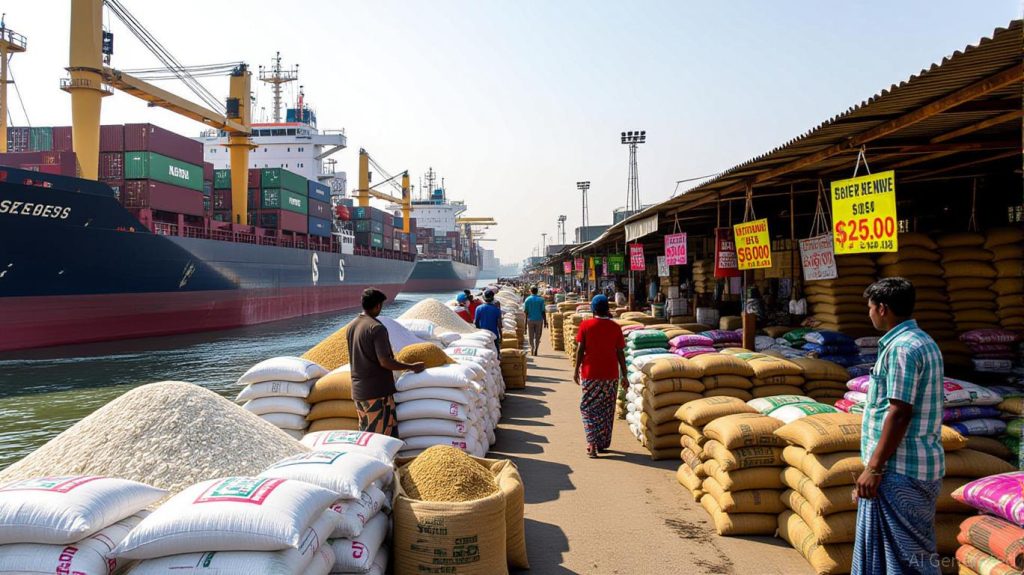Tags
Global Rice Market Divergence: India’s Price Plunge vs. Bangladesh’s Inflationary Surge
Albert Fox

The global rice market is fracturing under the weight of divergent economic forces. On one side, India’s record production and depreciating rupee are driving rice prices to multi-year lows, flooding global markets with cheap grain. On the other, Bangladesh—despite a robust harvest—struggles with stubborn inflation and acute food insecurity. This divergence presents a unique investment landscape, where supply-demand imbalances and currency dynamics redefine opportunities in agri-commodity trading, currency-hedged instruments, and regional food security equities.
India: Oversupply, Weak Rupee, and Price Suppression
India’s rice production in 2024/25 hit an unprecedented 151 million metric tons (MMT), supported by favorable monsoons and aggressive government subsidies. The removal of export restrictions in March 2025 triggered a surge in shipments, with exports projected to reach 24 MMT in the 2025/26 marketing year. This flood of supply has pushed global rice prices to near two-year lows, with non-basmati rice trading at $12 per hundredweight in May 2025—the cheapest level since 2020.
The Indian rupee’s depreciation, hitting 89.5 to the dollar in May 2025, has amplified this price pressure. A weaker rupee makes Indian rice cheaper for global buyers, outcompeting traditional rivals like Thailand and Vietnam. For example, Indian basmati rice now sells at a 25% discount to Thai jasmine rice. However, this dynamic is a double-edged sword: while it strengthens export margins, it raises costs for imports of fertilizers, machinery, and edible oils, straining India’s trade deficit.
Bangladesh: Harvest Abundance vs. Inflationary Headwinds
Contrastingly, Bangladesh’s 2025 Boro paddy crop—accounting for 55% of annual output—is projected to exceed five-year averages, with favorable weather and high-yielding seeds boosting yields. Yet, rice prices in Dhaka have risen 8% year-on-year, driven by inflation in production, milling, and transportation costs. Food inflation in Bangladesh hit 9.2% in April 2025, with rice prices stubbornly elevated despite a record 5.2 MMT paddy harvest in 2024.
The paradox lies in Bangladesh’s reliance on imports. Rice imports surged 2,900% year-on-year to $492 million in early 2025, partly due to floods destroying 1.3 MMT of Aman rice. However, imported rice has failed to alleviate domestic price pressures. The Bangladeshi taka’s depreciation (though not quantified in data) likely exacerbates import costs, while Cyclone Remal’s damage to agricultural infrastructure has disrupted local supply chains.
Currency and Structural Imbalances: A Tale of Two Markets
The Indian rupee’s depreciation has created a competitive edge for rice exports, but it also highlights structural weaknesses in Bangladesh’s currency and policy framework. While India leverages its surplus to dominate global markets, Bangladesh’s fragmented policies and vulnerability to climate shocks leave it exposed to inflationary shocks.
For investors, this divergence opens three strategic avenues:
1. Agri-Exporters in India: Companies like ITC Limited and Nandini Brewaries, which dominate rice processing and premium varieties, benefit from India’s pricing power. Their margins are further insulated by forward contracts locking in favorable rupee-dollar rates.
2. Currency-Hedged ETFs: Instruments like the India Earnings Hedged Fund (WMIN) mitigate rupee volatility while capitalizing on India’s rice export boom.
3. Food Security Equities in Bangladesh: Firms involved in agricultural infrastructure, fertilizer distribution, and climate-resilient crop development—such as Bangladesh’s AgroTech Innovations Ltd.—offer long-term upside as the country addresses supply-side inefficiencies.
Risks and Strategic Entry Points
While India’s rice export boom is well-entrenched, risks include monsoon failures in 2025 and potential RBI intervention to curb rupee depreciation. For Bangladesh, political instability and climate vulnerabilities could delay structural reforms. Investors should monitor the INR/THB exchange rate (currently 2.64) and Bangladesh’s cereal import policies.
Conclusion: Navigating the Divergence
The global rice market’s bifurcation reflects broader trends in emerging market agri-commodities: oversupply-driven deflation in export hubs versus inflationary pressures in import-dependent economies. For investors, the key lies in capitalizing on India’s pricing momentum through agri-export equities and hedged instruments, while selectively targeting Bangladesh’s food security infrastructure. As climate and policy shocks reshape supply chains, those who align with these divergent currents will find fertile ground for returns.
https://www.ainvest.com/news/global-rice-market-divergence-india-price-plunge-bangladesh-inflationary-surge-2507/Published Date: July 25, 2025






